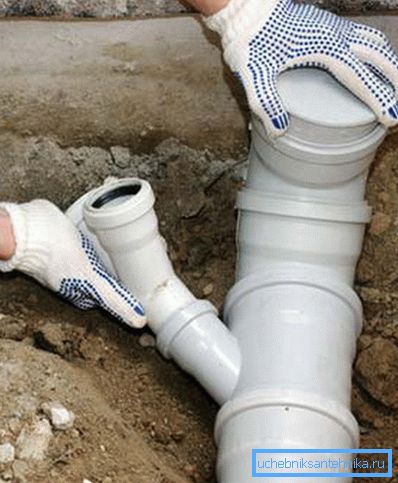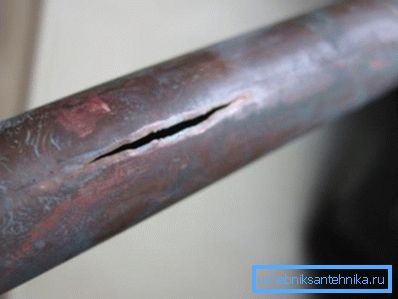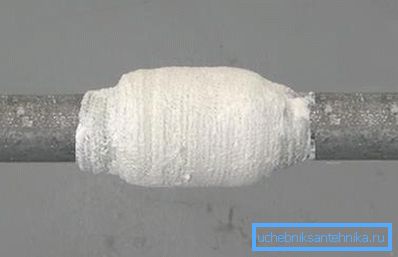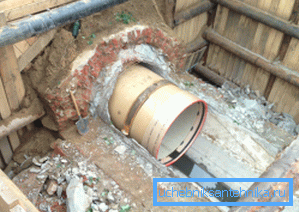Do-it-yourself sewer pipe repair: practical tips and tricks
You do not know how to eliminate the stench from the sewer pipe or how to seal the leak? In this case, this article will be useful for you. After all, the topic of repair or preventive maintenance of the wastewater disposal system, sooner or later, is of interest to the owners of apartments or country houses.
Considering that the price of the services of professional plumbers is high, it is better to eliminate such problems on your own, as you can save money and gain useful experience. So, what is the instruction for troubleshooting sewer problems?

A radical solution to the problem - complete replacement of the pipeline

Planning overhaul in the house? In this case, a complete replacement of the pipeline will be the most effective solution, especially since assembling sewage pipes with your own hands using modern materials does not pose a special challenge.
Getting to the complete replacement of domestic sewage, it is necessary to determine the type of pipe. Until recently, sewers were built using cast iron components, which had many flaws, the main of which is the tendency to blockage.
That is why everywhere there has been a rejection of metal pipelines designed for the discharge of wastewater. What should be used as an alternative to metal products?

If you are interested in a long operational resource of the internal sewerage, it is reasonable to use polymeric pipes.
Important: Special grease for sewer pipes will simplify installation with the use of a socket.
For example, an excellent solution is polyethylene products, which are characterized by such advantages as:
- operational resource not less than 50 years;
- absolute resistance to corrosive processes;
- ideally smooth internal surface and, as a result, there is no accumulation of sedimentary pollution, and therefore there are no blockages;
- reasonable price in comparison with pig-iron analogs;
- ease of installation and the ability to replace the sewer system with their own hands without the involvement of specialists.
Important: A properly installed audit on the sewer pipe will greatly simplify the removal of blockages and regular maintenance of the system.
Instead of thinking about how to plug a sewer pipe, it is better to completely replace defective communications and be sure that the problem will not happen again.
But a significant disadvantage of a complete replacement of sewage is that such work is carried out only during the overhaul. If it is far to overhaul, the problem of leakage or blockage will have to be solved by other means.
We repair the cracks and cracks

Before you cool the sewer pipe cold-welding, think that this method is short-lived. Moreover, products based on epoxy glue should be applied to the previously cleaned and, most importantly, dry metal.
Considering that pipe damage is manifested by a leak, a self-made shroud coupling will be a much more appropriate solution. Such temporary couplings can be used for several years, after which it will be possible to find the means and time to replace the problem section of the pipeline.

Repair instructions are not difficult:
- We find a crack (of course, it is possible to repair open sections of pipes, whereas it will not be possible to repair hidden leaks in this way);
- In specialized stores we buy 2-3 long clamps for the diameter of the pipeline being repaired;
- In addition, we buy tires twice or three times wider than cracks;
- We soak the liquid out of the crack with a dry cloth and immediately tightly wrap the pipe with a rubber overlay;
- We put collars on top of the rubber winding so that, when tightening, they tightened the rubber patch even more.
- Of course, such a measure is temporary and as soon as possible the damaged section of the pipeline needs to be replaced.

Another variation on the bandage at the site of a leak involves the use of cement and liquid glass. The method is relevant if the crack is small and leaky non-permanent.
The instruction is as follows:
- knead the cement with liquid glass with the addition of a small amount of water, so that a viscous porridge is obtained;
- in the resulting composition, soak up the medical bandage;
- we wrap the pipe wiped before dry with such a bandage in several layers so that the winding on each side protrudes about 5 cm beyond the crack.
The advantage of this method is that after the leak is eliminated, there will be no smell of sewage in the room at all.
Important: In no case should wedges be crammed into the crack, as this will not eliminate the leakage, but will only lead to even more damage.
Sanitation - high-tech solution to intractable problems
The best solution to avoid repair work is the prevention of sewage pipes. But if the trouble nevertheless happened, and the system started to leak, a professionally executed rehabilitation will help.

Sanitation of sewer pipes is the process of filling the internal cavity of the damaged area with a flexible polymer sleeve. The technology is good because it allows you to carry out effective repair work with a knowingly successful result without replacing the problem section of the pipeline.
Trenchless rehabilitation through a polymer hose has the following advantages:
- the use of the existing route and, as a consequence, the affordable price of the finished result;
- short deadlines for work;
- integrity of communications located near the pipeline being restored;
- possibility of laying the hose with bends up to 90 degrees, which allows restoring systems of various configurations and complexity;
- resistance of the polymer hose to corrosive processes and abrasive wear;
- the minimum degree of narrowing of the cross section of the existing system;
- the service life of the sleeve is at least 50 years without the need for subsequent repair.
Conclusion
So, we got acquainted with the main points of the sewer repair. To cope with most of the repair work, with the exception of rehabilitation, you can do it yourself using a simple and affordable tool.
Have any questions? More useful information you can find by watching the video in this article.